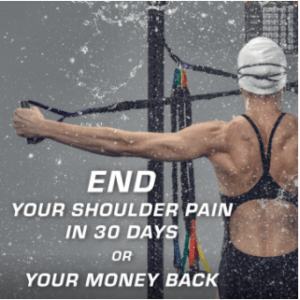Swimmers put more volume on the shoulder than any other sport– roughly 4000 repetitions daily. Thus, it’s no surprise shoulder pain is the most common complaint among swimmers (1).
Shoulder pain is often deemed an issue with stroke mechanics, with training directed at developing a stronger or more perfect stroke being the answer. But hammering the same movement (that has already seen 4000 reps) often does not get rid of the pain. Why?
Because it fails to address the rotator cuff strength imbalances and postural issues that result from swimming large volumes on a daily basis.
Imagine a tug of war happening inside your shoulder. As you move, rotator cuff muscles work in different directions to keep the shoulder out of impingement. But as you swim and repeat the same stroke thousands of times a day, one “side” of that tug-of-war gets stronger. It begins to over-power the other “side” and impingement and pain occurs with the ultimate result being changes in swim mechanics (4).
By addressing strength and mobility first, the ability to improve swim mechanics becomes more effective. Here’s 5 ways swimming thousands of repetitive strokes is bullying your shoulders into impingement, and how you can correct them.
- The Swim Bully: Weak external rotation shoulder strength compared to stronger internal rotation strength (2).
The Fix: Strengthen and develop the external rotators of the shoulder.
Example: Use the Crossover Strength Program as part of dryland training.
- The Swim Bully: Weak, fatigued, or inhibited Serratus Anterior (3, 4).
The Fix: Strengthen and develop endurance for scapular protraction.
Example: Use the Crossover Symmetry Activation program as part of your warm-up.
- The Swim Bully: Tight anterior chest and latissimus dorsi.
The Fix: Daily massage or myofascial release (foam rolling, etc.) of trigger points, followed by some stretches for these tight muscles.
Example:
Video Link: Thoracic Extension
Video Link: Book Opener
- The Swim Bully: Loose anterior capsule paired with a tight posterior cuff/capsule (5).
The Fix: Stretch the posterior shoulder.
Example: Genie Stretch
- The Swim Bully: Breakdown in coordination between the scap and humerus
The Fix: Use functional movements that simultaneously work multiple joint segments as part of your dryland training. Start by focusing on tuning scapula movement, and then pair it with associated glenohumeral movements.
Example: Scale up your warm-up using the Crossover Symmetry Activation+ program.
Focusing on better mobility, stability, and coordination will pay huge dividends when it comes to ending pain. So start here before breaking down stroke mechanics.
How does Crossover Symmetry Work?
The Crossover Symmetry System is the perfect adjunct to time spent in the pool. It’s not designed to replace your training, but rather a necessary prerequisite and accessory dryland work to be incorporated into a complete training program. It includes programs for muscle activation, recovery, speed, strength, and mobility, (each program only takes 5 minutes to complete.) The Crossover Symmetry System includes a complete online training and education platform, making it a complete system to end your shoulder pain and take your training to the next level.
About Crossover Symmetry
BORN FROM SCIENCE – VALIDATED BY ATHLETES Crossover Symmetry is an evidence-based shoulder health and performance system, developed by top sports physical therapists, athletes and coaches. The programs are designed to facilitate safe and efficient shoulder mechanics in order to eliminate pain, reduce the risk of injury and optimize performance. Over 75% of Div 1 University athletic programs and thousands of rehab facilities use Crossover Symmetry on a daily basis.
Citations:
- Allegrucci M, Whitney SL, Irrgang JJ. Clinical implications of secondary
impingement of the shoulder in freestyle swimmers. J Orthop Sports Phys Ther.
1994 Dec;20(6):307-18. - McMaster WC, Long SC, Ciazzo VS. Shoulder torque changes in the swimming athlete. Am I Sports Med 20(3):323-327, 1992.
- Pink M, Perry I, Browne A, Scovazzo ML, Kerrigan I. The normal shoulder during freestyle swimming: An electromyographic and cinematographic analysis of twelve muscles. Am I Sports Med 19(6):569-576, 1991.
- Scovazzo ML, Browne A, Pink M, Jobe FW, Kerrigan J. The painful shoulder
during freestyle swimming. An electromyographic cinematographic analysis of
twelve muscles. Am I Sports Med 19(6):569-576, 1991. - Warnerll, Micheli LI, Arslanian LE: Patterns of flexibility, laxity, and strength, in normal shoulders and shoulders with instability and impingement. Am I Sports Med 18(4):366-375, 1990.
Swimming gear news is of Crossover Symmetry, a SwimSwam partner.

I’m going to do the thoracic extension to improve my streamline!
As far as high repetition swimming creating muscle imbalances that create impingement, you haven’t convinced me. For one, your references are from the era when everyone was pulling with an S-shaped motion. Another is that entering thumb first has been said to cause shoulder pain. That, however, I’m not sure about. If, however, the repetition is done with poor biomechanics, i.e. poor leverage, then the chance of inflammation increases, and therefore, impingement.
I watched the video on the crossover website but aside from a lot of generalities, I don’t think there was any there there. If I’m going to convince my head coach to buy into the CSS, then… Read more »
Appreciate your comments. I have provided a more contemporary study below, but the bigger issue is that the body will adapt no matter what your mechanics are – new era or old. The new era swim mechanics have not solved the shoulder issues that are so common with swimmers. According to your logic, Olympic level swimmers (who have the best mechanics) shouldn’t struggle with shoulder pain – but as you know they do.
This is not a fault of swim mechanics. And that is my point. Once you acknowledge that our bodies adapt to the workloads we put on them, then we must plan for those changes in our training. I believe the Crossover Symmetry program addresses these changes… Read more »